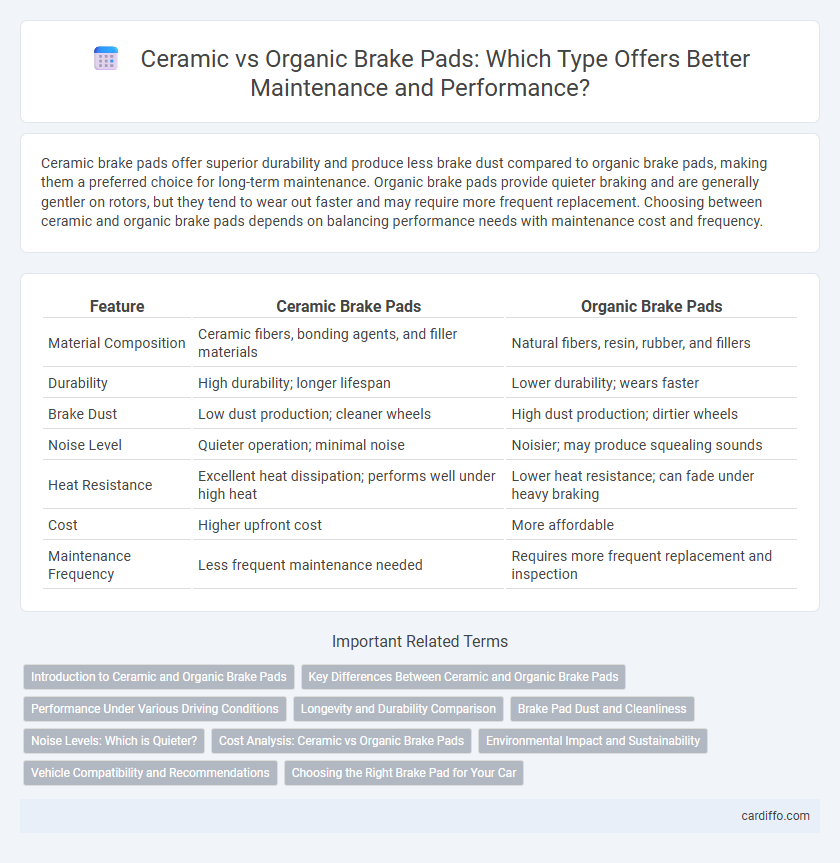Ceramic brake pads offer superior durability and produce less brake dust compared to organic brake pads, making them a preferred choice for long-term maintenance. Organic brake pads provide quieter braking and are generally gentler on rotors, but they tend to wear out faster and may require more frequent replacement. Choosing between ceramic and organic brake pads depends on balancing performance needs with maintenance cost and frequency.
Table of Comparison
| Feature | Ceramic Brake Pads | Organic Brake Pads |
|---|---|---|
| Material Composition | Ceramic fibers, bonding agents, and filler materials | Natural fibers, resin, rubber, and fillers |
| Durability | High durability; longer lifespan | Lower durability; wears faster |
| Brake Dust | Low dust production; cleaner wheels | High dust production; dirtier wheels |
| Noise Level | Quieter operation; minimal noise | Noisier; may produce squealing sounds |
| Heat Resistance | Excellent heat dissipation; performs well under high heat | Lower heat resistance; can fade under heavy braking |
| Cost | Higher upfront cost | More affordable |
| Maintenance Frequency | Less frequent maintenance needed | Requires more frequent replacement and inspection |
Introduction to Ceramic and Organic Brake Pads
Ceramic brake pads consist of ceramic fibers, bonding agents, and small amounts of metal, offering excellent heat dissipation, low noise, and minimal dust production. Organic brake pads, made from a mixture of fibers, resins, and fillers, provide quieter operation and are generally softer, reducing wear on brake rotors. Understanding the material composition and performance characteristics is crucial for selecting the appropriate brake pad type for specific driving conditions and maintenance requirements.
Key Differences Between Ceramic and Organic Brake Pads
Ceramic brake pads offer superior durability and produce less dust compared to organic brake pads, which are made from natural materials like rubber and resin and wear out faster. Organic pads provide quieter braking and better initial bite, but they generate more dust and tend to fade under high temperatures. The choice between ceramic and organic brake pads depends on driving habits, with ceramic pads favored for longevity and cleanliness and organic pads preferred for cost-effectiveness and quieter operation.
Performance Under Various Driving Conditions
Ceramic brake pads provide consistent performance and reduced brake dust across a wide range of temperatures, making them ideal for both city driving and high-speed conditions. Organic brake pads offer quieter operation and better initial bite but tend to wear faster and may fade under heavy braking or extreme heat. Selecting ceramic pads ensures durability and stable stopping power in diverse driving environments, while organic pads are better suited for lighter, everyday use.
Longevity and Durability Comparison
Ceramic brake pads offer superior longevity and durability due to their harder composition and resistance to wear, often lasting 30-40% longer than organic brake pads. Organic brake pads, made from softer materials like rubber and glass, tend to wear out faster under heavy use and high temperatures. For drivers prioritizing long-term maintenance, ceramic pads reduce the frequency of replacements and provide consistent performance over extended periods.
Brake Pad Dust and Cleanliness
Ceramic brake pads generate significantly less brake dust compared to organic pads, resulting in cleaner wheels and reduced need for frequent cleaning. The finer, lighter dust from ceramic pads is less likely to accumulate on the braking system, helping to maintain optimal performance and appearance. Organic brake pads produce more abrasive dust, which can lead to buildup that may attract dirt and cause corrosion over time.
Noise Levels: Which is Quieter?
Ceramic brake pads generally produce less noise compared to organic brake pads due to their dense and smooth composition, which reduces vibrations that cause squealing. Organic brake pads tend to generate more sound because of their softer materials and higher resin content, leading to increased friction noise during braking. For quieter operation and reduced noise pollution, ceramic brake pads are the preferred choice in vehicle maintenance.
Cost Analysis: Ceramic vs Organic Brake Pads
Ceramic brake pads typically cost 20-30% more upfront compared to organic brake pads, but they offer longer lifespan and reduced wear on rotors, leading to lower overall maintenance expenses. Organic brake pads have a lower initial price but may require more frequent replacement due to faster wear and higher dust accumulation, increasing long-term costs. Evaluating cost per mile and vehicle usage is crucial to determine the most economical choice between ceramic and organic brake pads.
Environmental Impact and Sustainability
Ceramic brake pads generate less dust and produce fewer harmful particulates compared to organic brake pads, reducing environmental pollution and improving air quality. Their longer lifespan and superior durability decrease the frequency of replacements, contributing to sustainable resource use and less landfill waste. Organic brake pads typically contain biodegradeable materials but wear faster, leading to more frequent manufacturing and disposal cycles, increasing their overall environmental footprint.
Vehicle Compatibility and Recommendations
Ceramic brake pads are highly compatible with a wide range of passenger vehicles, including sedans and SUVs, due to their durability and low dust production, making them ideal for daily driving and light-duty applications. Organic brake pads, composed of natural materials like glass and rubber, work best with older or smaller vehicles, offering quieter braking but wearing faster under heavy use. For optimal maintenance, choose ceramic pads for vehicles requiring longevity and cleaner components, while organic pads suit budget-conscious owners driving less demanding routes.
Choosing the Right Brake Pad for Your Car
Ceramic brake pads offer superior durability, produce less dust, and provide quieter braking compared to organic brake pads, making them ideal for daily drivers seeking low maintenance. Organic brake pads, composed of natural fibers and resins, deliver better initial bite and a softer feel, which suits lightweight vehicles and those prioritizing cost-effectiveness. Evaluating factors such as driving habits, vehicle type, and maintenance frequency helps determine whether the high performance of ceramic or the budget-friendly resilience of organic brake pads is the best fit for your car.
Ceramic brake pads vs organic brake pads Infographic

 cardiffo.com
cardiffo.com